This is a Konica Auto S1.6, a 35mm rangefinder camera made by Konishiroku Photo Industries starting in 1967. The Auto S1.6 is a revised version of the earlier Auto S2 with a slightly faster 7-element f/1.6 lens, an improved shutter, and a flash hot shoe. It was the final model in the Konica Auto S family of full size rangefinders before the company switched to a much more compact design. The Auto S1.6 is one of only a few fixed lens rangefinder cameras with a lens faster than f/1.7, and combined with it’s good build quality and fully manual operation, is quite a capable camera today.
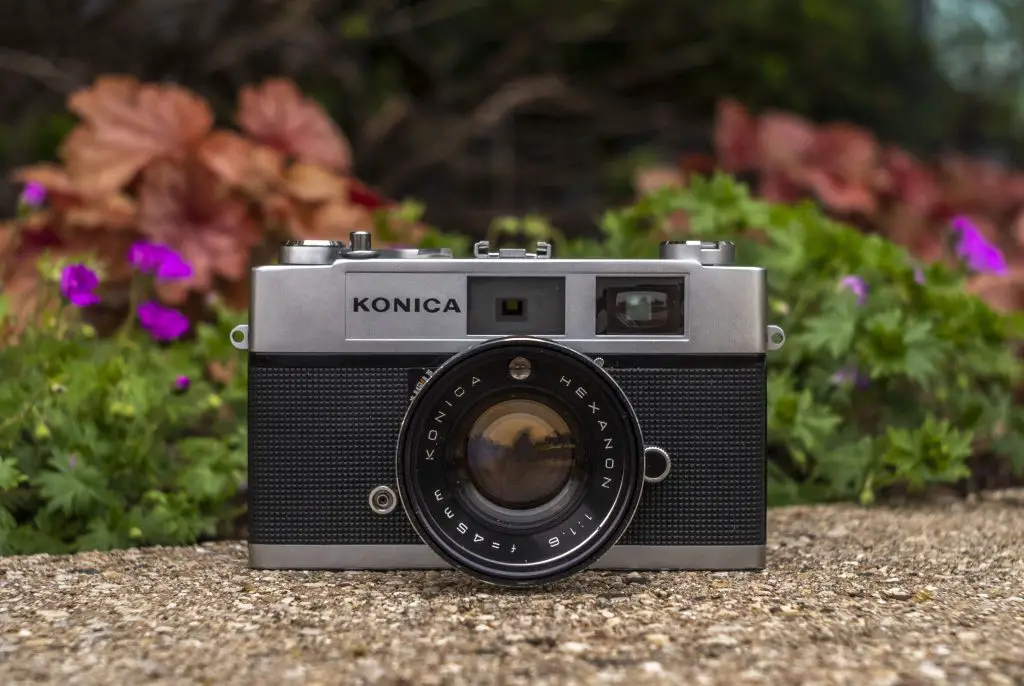 Film Type: 135 (35mm)
Film Type: 135 (35mm)
Lens: 45mm f/1.6 Konica Hexanon coated 7-elements
Focus: 3 feet to Infinity
Viewfinder: Coincident Image Coupled Rangefinder with Projected Frame Lines, Automatic Parallax and Field Correction
Shutter: Copal SVA Automatic Leaf
Speeds: B, 1 – 1/500 seconds
Exposure Meter: Coupled CdS Cell w/ viewfinder match needle and Shutter Priority AE
Battery: 1.35v PX625 Mercury
Flash Mount: Hot shoe and PC port M and X Flash Sync, X-Sync at all speeds
Weight: 783 grams
Manual (similar model): https://www.cameramanuals.org/konica/konica_auto_s2-02.pdf
How these ratings work |
The Konica Auto S1.6 is an update to the Auto S2 with a faster lens, flash hot shoe, and a built in lens hood, but otherwise retains all of the great features of that camera. It has one of the largest and easiest to use viewfinders of any fixed lens rangefinder, a world class lens, and good ergonomics, and with used prices sometimes less than $20 is one of the biggest bargains in classic rangefinders. This is an excellent camera, that even if found with a dead meter, is worth picking up for it’s ease of use and sharp lens. Highly Recommended! | ||||||
| Images | Handling | Features | Viewfinder | Feel & Beauty | History | Age | |
| 2 | 1 | 2 | 2 | 1 | 1 | 20% | |
| Bonus | +1 for one of the best viewfinders ever and excellent optics | ||||||
| Final Score | 11.8 | ||||||
History
Konica was once a Japanese maker of cameras and lenses that could trace it’s history back farther than any other Japanese optics company. Starting out in 1873 as a pharmacy supply company, Konica’s founder Rokusaburo Sugiura would start to produce photographic supplies in 1882 and over the course of the next several decades, continue to increase it’s presence in the optics industry.
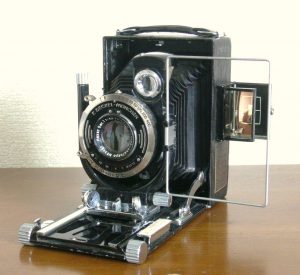
In the years between the two world wars, the company, then called G.K. Konishiroku Honten built both the first commercially available Japanese camera and the company’s first Hexar lenses in 11.5cm and 13.5cm focal lengths. These lenses were commonly found on large format folding Rokuoh-sha Lily cameras.
Like most Japanese optics companies, the war brought uncertainty to Konishiroku. Little evidence exists as to exactly what the company was up to, but it can be assumed they produced items for the Japanese war effort.
After the war, American Occuption Forces had an incentive to rebuild the Japanese economy so that the US could maintain a stronghold in the Pacific region. The fastest way to do this was to find products that Japanese companies were skilled at making, and could produce quickly, so companies like Nippon Kogaku (Nikon), Canon, Chiyoda Kogaku (Minolta), and Konishiroku were tasked with building cameras and lenses.

In 1947, Konishiroku released their first 35mm rangefinder camera, known simply as the “Konica”. The name was a combination of “Konishiroku”, and “camera”, which was a trend started by the German company Leitz with their first Leica, and followed by many other Japanese companies like Nicca and Yashica.
Over the course of the next twelve or so years, Konica would continually revise and release updated versions of that original Konica, which is known today as the Konica I, all the way to the Konica IIIM in 1959.
The Konica IIIM was the company’s first 35mm rangefinder with an uncoupled exposure meter, but it was done via a folding panel, added to the meterless Konica IIIA. It was an inelegant solution to a feature that many were beginning to expect from a new camera.
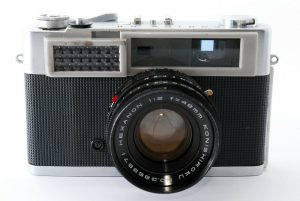
At the same time as the IIIM, an all new model, called the Konica S was being developed. The Konica S would be the company’s first model with a coupled meter. It was built into a large and boxy body, available with three different fixed lenses, ranging from a 6-element f/1.8 Hexanon to a 4-element f/2.8 Hexanon.
The Konica S would be replaced in 1963 by the Auto S, which was essentially the same camera, but came with a battery powered CdS meter capable of shutter priority automatic exposure. Following the lead from Canon and Minolta with their Canonet and Hi-Matic rangefinders, Konica helped popularize automatic exposure in the intermediate 35mm rangefinder market with innovative new cameras with fast lenses and good shutters.
As every company back then did, the Konica Auto S received regular updates. The first of which was Auto S2, released in 1965. This model would prove to be one of Konica’s most successful of the era, staying in production for about four years. The Auto S2 improved upon the earlier model with a new Hexanon 45mm f/1.8 lens and an upgraded CdS meter that was contained within the filter ring, meaning that attaching filters would not throw off the meter reading. At a price of “under” $110, Konica heavily advertised the Auto S2 as having a lens that’s worth the price.
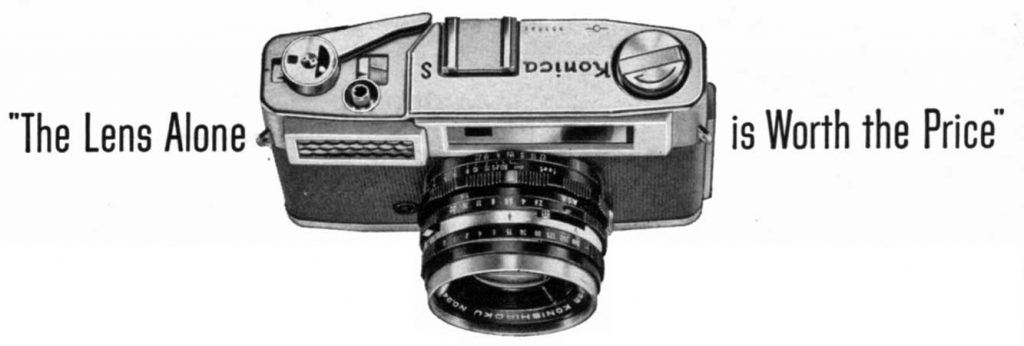
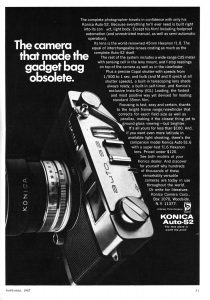
Although a popular model, by the time the Auto S2 was on the market, SLRs were continuing to grow in popularity and with more compact models being offered by Asahi Pentax and Petri, the need for more compact cameras was clear to companies like Konica. Realizing the need to invest more into SLR models, Konica wasn’t willing to completely give up on rangefinders yet, and decided to sweeten the pot with an updated model that added a flash hot shoe and an even faster f/1.6 lens.
This new model, called the Konica Auto S1.6 would debut in 1967 and would sell concurrently with the Auto S2. Ads from the era show that the Auto S2’s price was reduced by $10 to “under $99” and the f/1.6 model sold for $20 more, which likely means a $119.50 retail price. That price, when adjusted for inflation, compares to about $920 today. Another ad from November 1968 shows a price drop for the Auto S1.6 to “under $110”.
Konica would continue selling the Auto S2 until 1973 when they would release their last model, the Konica Auto S3. The name Auto S3 is a bit confusing as other than being a 35mm rangefinder made by Konica, it shared almost nothing with previous Auto S models. It had an entirely new and much smaller body, a new 6-element 38mm f/1.8 lens, a Copal electronic shutter, and offered shutter priority automatic exposure without the ability for full manual control.
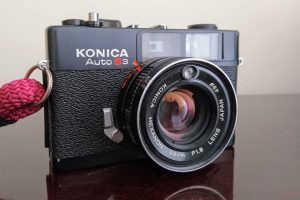
The Auto S3 was popular enough to stay in production for four years before being discontinued and is a highly sought after camera today for it’s compact size, good looks, and excellent performance
Today, fixed lens Konica rangefinders are generally well regarded cameras for collectors and shooters alike. No one questions the quality of the Hexanon lenses each of these models used, but some of the cost cutting measures such as the plastic lens mount on the Auto S series have come back to plague the reliability of these cameras today.
The good news is these cameras are plentiful and often very cheap. Collectors can often find used Auto S2s for very little, and even if the meters don’t work, the camera almost always can be used mechanically, making for an excellent value in the classic rangefinder segment. If you are a collector, and somehow have never come across one of these cameras, it’s worth what little you’d pay to try one out.
My Thoughts
Back in January 2015, I published a review for the Wards am551, which is a name variant of the Konica Auto S2, sold by the US department store chain Montgomery Wards. That review was one of the first I ever wrote (I just checked and it was my 6th review) and in the years since I figured I should probably either revisit it, or perhaps even review an actual Konica Auto S2.
Since then, I’ve actually come across two different Auto S2s, one of which came in it’s original box with paperwork, but sadly, neither worked. This was a common camera I thought, so eventually another would come my way.
I was sort of right. At first glance, the Konica Auto S1.6 looks identical to the Auto S2 other than the name and the slightly faster lens. Upon closer look, there’s a few other small changes, like the flash hot shoe, and a completely different Copal SVA shutter, but otherwise these two cameras are largely the same.
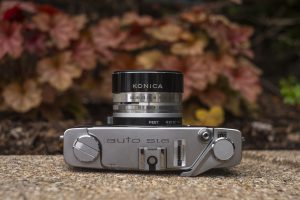
The top plate of the camera has from left to right the rewind knob with fold out handle, flash hot shoe in the center, top plate meter read out, cable threaded shutter release, rapid wind lever, and automatic resetting exposure counter.
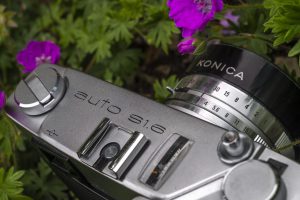
My favorite part of the top of the camera though is the logo. I am a sucker for typefaces and the lower case “auto s2” is both modern and retro. This typeface is my second favorite on any camera, narrowly edged out by the Minolta Uniomat III. I don’t know what either of these fonts are called, but if I could change my entire site to look like these letters, I would!

The bottom of the camera has the rewind release button, centrally located 1/4″ tripod socket, battery check button, and circular battery compartment. Strangely, the battery compartment cover is made of gray plastic which considering many cameras with metal ones can get pretty chewed up, I wonder how good of a decision this was.
On the bottom of the shutter, you can see the ASA film speed selector for use when shooting the camera in auto exposure mode.
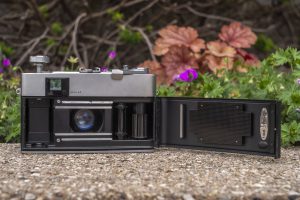
Opening the back of the camera requires lifting up on the rewind knob and giving it a tug. At the time, this would have been considered a modern feature as many cameras of the era still used a side mounted door latch. With the right hinged door open, we seen a pretty typical film compartment. Film transports from left to right onto a fixed, multi slotted take up spool. Loading film into the camera is very easy as the supply side is large and with the rewind knob up, allows a new cassette to slide in and with the many slots on the take up spool, the film leader attaches very easily. The film pressure plate is very large and has divots on it to minimize resistance as film travels through the camera.
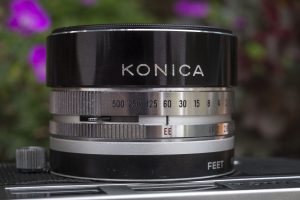
All of the camera’s exposure controls are done using two rings around the shutter. The larger and farthest from the body selects shutter speeds from 500 to 1 second, plus Bulb, and the one closer to the body selects f/stops, or when put in “EE” mode, enables shutter priority auto exposure. Thankfully, the Auto S1.6 does not have any kind of EV or LV coupling that drives me crazy on other mid century rangefinder cameras. To the left of both rings is a level for the mechanical self-timer.
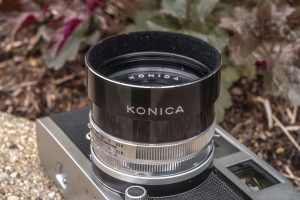
A neat feature of this camera that was available on the Auto S2 as well, is the built in lens hood. Simply pull outward on the black ring around the lens and a felt lined hood extends about two centimeters out.
Of all the reasons to like the Konica Auto S1.6, without a doubt, my favorite is the viewfinder. Including the Auto S2 which has the same viewfinder, this is the best viewfinder in any Japanese 35mm rangefinder camera ever, and yes, I am including Nikon and Canon too.
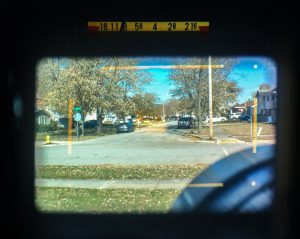
For starters, it is big. With prescription glasses, I can very easily see the projected frame lines in all four corners. Second, the contrast is excellent. With a blue tint to the main viewfinder, the yellow tint of the frame lines, rangefinder patch, and meter readout is extremely easy to see, even in low light. Third, the rangefinder patch is very large. Compared to other cameras that rely on a circular or diamond shape rangefinder patch, the one on the Auto S1.6 is nearly the same size as the one on a Leica M3 which almost everyone considers to be the benchmark for rangefinders. Fourth, the meter readout at the top is extremely easy to read, with large bold numbers indicating which f/stop the meter is recommending both in EE and manual modes.
Finally, and perhaps the coolest, is that the Konica Auto S1.6 is the only camera I know of that has both automatic parallax correction, but also automatic field correction. Unlike other cameras with automatic parallax correction in which the frame lines gradually move towards the bottom right corner as you select a closer focus distance, the frame lines on the Auto S1.6 also shrink in size to accommodate what’s called field distortion. Since viewfinders on rangefinder cameras do not show 100% of the image that will pass through the lens, most don’t bother with field correction as the small change in size at closer distances is “good enough”, but Konica saw it fit to correct for that too.
Take a look at the short video below of the viewfinder as I move from infinity to minimum focus and back. It was very difficult to record this with my cell phone, but you should get the idea that the frame lines both move towards the bottom right corner while getting smaller at the same time.
With one of the best viewfinders found on any fixed lens rangefinder, a fast f/1.6 Hexanon lens, and both auto exposure and full manual control, there is a ton to like about the Konica Auto S1.6. As I say at this point in most of my reviews, but how does it shoot? Keep reading!
Repairs
I was lucky enough that this Auto S1.6 came to me in good working order, but I found this archived post showing some basic steps for taking apart the camera to adjust the rangefinder and repair the mirror if it were to fall out of position.
https://web.archive.org/web/20170904010257/http://www.kyphoto.com/classics/konicaautos.html
If all you need is to clean or adjust your rangefinder, in her re-review of the S1.6, Peggy Marsh not only has some tips, but also a video showing how it’s done.
My Results
My first opportunity to shoot the Konica Auto S1.6 came at a time when I had a big supply of Kodak ProImage 100. I loaded up the camera and took it with me to visit family in Michigan and that meant a quick trip to Mackinaw City, one of my favorite places to shoot film. As is the case in northern Michigan, the weather changes by the hour, so what started out as a heavily overcast day turned into a beautiful sunny day with bright blue skies, perfect for a slow-ish color film!
I had a bit of a brain fart when shooting the Auto S1.6 in that I had completely forgotten that it was an Auto Exposure camera and shot more than half of the roll using the manual settings and my best Sunny 16 guesses. Once I turned on Auto mode, I shot the rest of the roll and upon looking at the images from that roll, I can’t see a difference. Despite this camera requiring a 1.35v Mercury battery and me using a 1.5v alkaline replacement, the voltage difference did not appear to have any effect on the metering accuracy, suggesting some kind of bridge circuit is correcting the voltage.
Clearly the meter was working well, and the ease of getting properly exposed shots was well within the camera’s capabilities even now, more than 50 years after it was built. Although this wasn’t my intention, it highlights one of the greatest strengths to the Auto S1.6 which is that when auto exposure started to become common on many 35mm rangefinders in the 1960s and 70s, manual controls disappeared. Cameras like the Yashica Electro still had large and heavy bodies with fast lenses capable of very sharp images, but sacrificed full manual control for the convenience of AE, but not the S1.6.
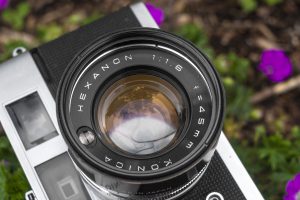
As you might imagine from any lens with the Hexanon name, the images were excellent. Sharpness extends from the center all the way to the edges, and I saw none of the anomalies often associated with lesser lenses. There was a discussion back in 2008 on photo.net from people asking about differences in lens performance of the f/1.8 Hexanon on the Auto S2 and the f/1.6 on this camera and although some people claimed to see a difference, I couldn’t. In fact, I would guess that any differences in performance can’t be seen on film. Although these are fixed lens cameras, it would take dissecting each camera and removing it’s lens to adapt to digital where maybe you could see a difference.
The Auto S1.6 is a fantastic camera. Everything there is to like about the Auto S2 applies, from the large and sturdy body, the incredibly bright and easy to use viewfinder that has both automatic parallax and field correction, an accurate and easy to use meter, full manual controls, an excellent lens, and an attractive and clean interface.
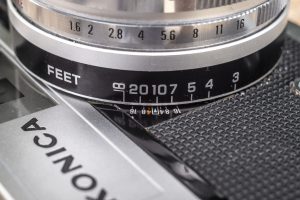
Unfortunately, two of the things not to like about the Auto S2 also apply. The first is the very short throw of the focus ring. A movement from minimum to infinity focus is done with maybe a 30 degree turn of the focus ring which in my opinion, is far too short. As a side effect to this, the short throw also results in one of the more worthless depth of field scales I’ve ever seen. I’m not suggesting it is necessary to have a full 360 degree rotation like that of a Vokar II, but somewhere around 90 degrees feels like a nice in between that can be accomplished with a single twist of the wrist, while still allowing for some focus precision. With such a short focus throw, you need every bit of brightness from that viewfinder to make sure you have the rangefinder properly lined up, especially if you want to shoot at the camera’s maximum f/1.6 aperture.
The other is Konica’s extremely poor decision to use a plastic lens mount. Even in fixed lens cameras, the lens is still attached to the body somehow, and on both the Auto S2 and Auto S1.6 the mounting surface is plastic, which results in nearly every example of these cameras having wobbly lenses. In most cases, this won’t negatively affect the performance of the camera, but it’s very concerning to hold your camera and feel the lens wiggling around in your hands.
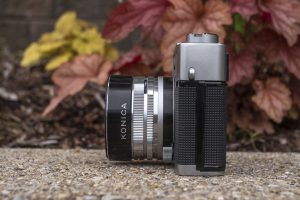
With those two cons out of the way, with a working meter, the Auto S1.6 is one of the better full size 35mm rangefinders out there. Even if you find one with a dead meter, it’s full manual control will allow for images like the ones above that are indistinguishable from those shot with a working meter.
The Konica Auto S1.6, and Auto S2 by association, are both terrific cameras. Perhaps two of the best fixed lens rangefinders ever made. I don’t think there are many collectors out there who don’t already know Konica made good cameras or that Hexanon lenses were as good as any out there, so why aren’t these cameras in higher demand?
The Auto S1.6 is uncommon because very few were made, but the Auto S2 was made in huge quantities, yet they often go unsold for $20 or under. Perhaps it’s the wobbly lens mount or the large and heavy body, but whatever the case, this is a camera that you should consider if one ever comes your way. Sure, they are subject to the same conditional issues as any other camera like a dead meter, corroded battery compartment, or lens fungus, but so are every other camera made from this era. The good news is, that at the prices these usually go for, you can afford to try more than one, and when you do find a working one, I guarantee you, you’ll be pleased with it’s results.
Related Posts You Might Enjoy
External Links
http://camera-wiki.org/wiki/Konica_Auto_S1.6
https://www.thorleyphotographics.com/?page_id=63
https://cameragocamera.com/2016/02/21/konica-auto-s1-6/
https://cameragocamera.com/2020/12/06/konica-kristmas-return-to-auto-s1-6/
https://www.photo.net/discuss/threads/konica-auto-s1-6-versus-auto-s2.351107/
https://www.rangefinderforum.com/forums/showthread.php?t=123763
http://dmc-365.blogspot.com/2013/06/skeletons-from-closet-june-camera-is.html

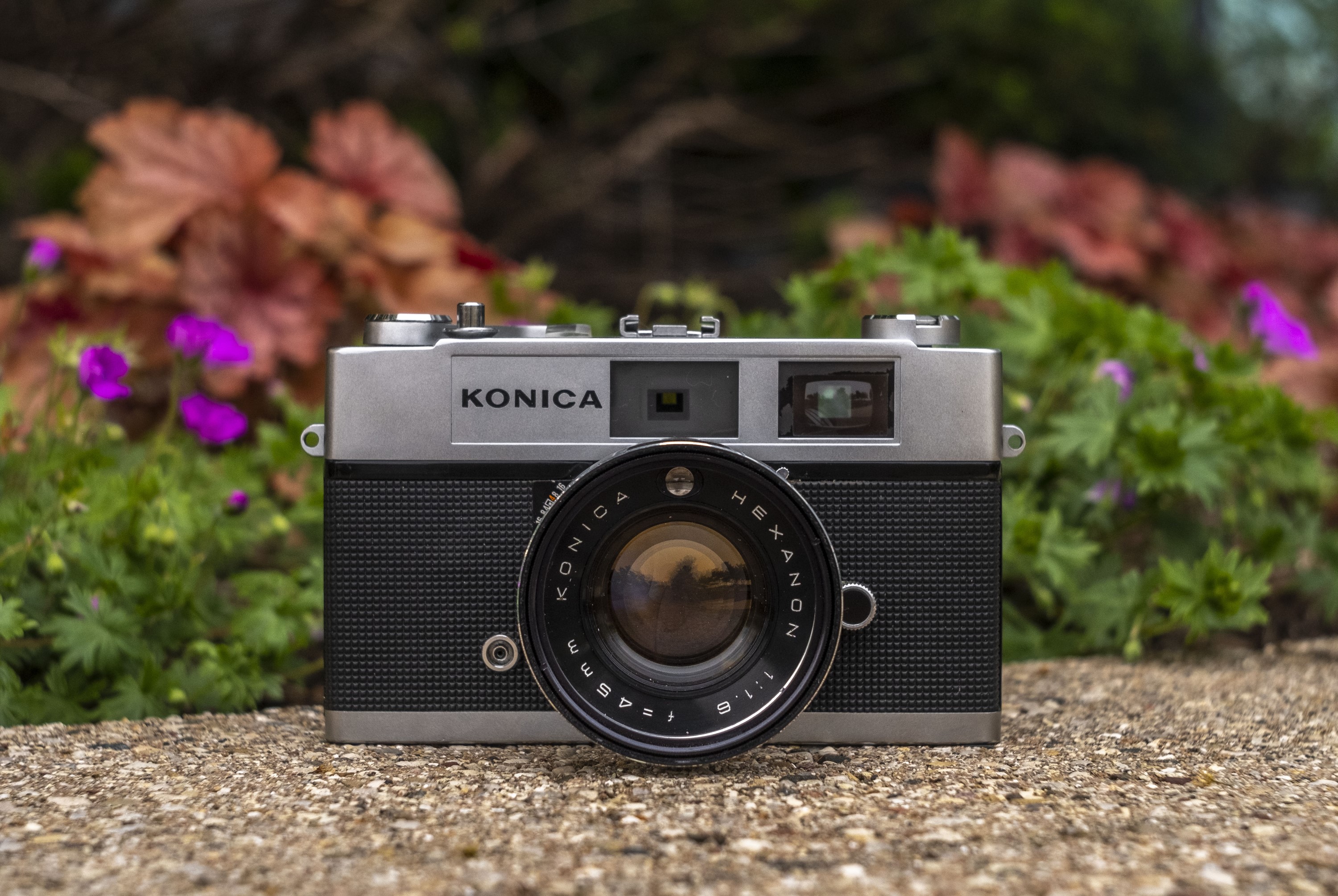
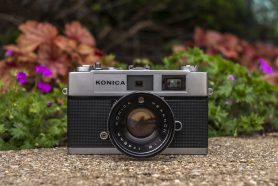
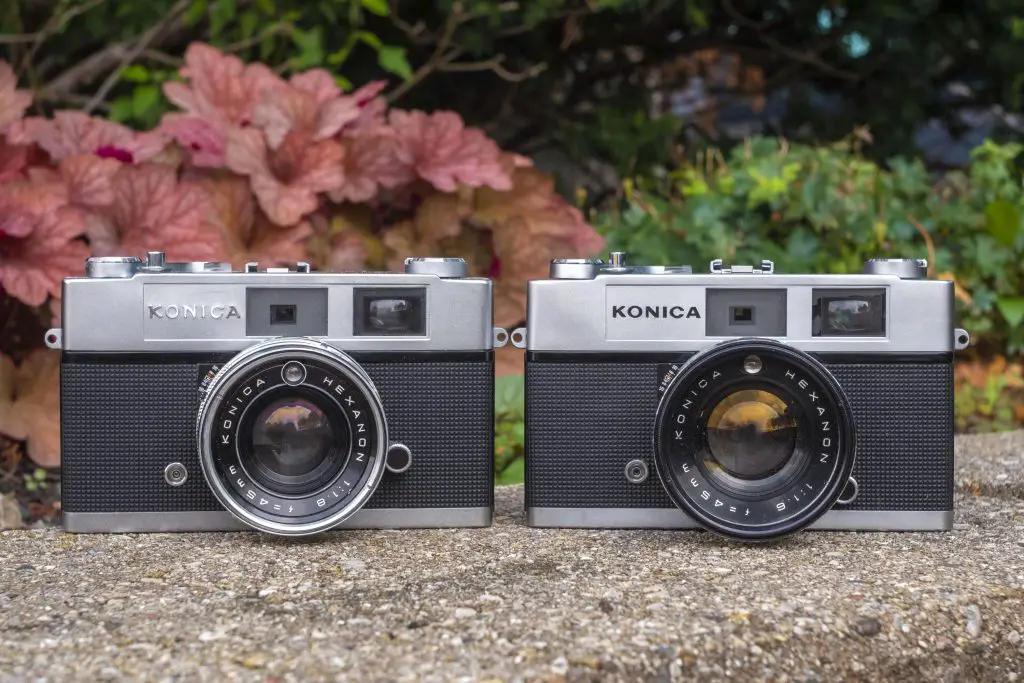
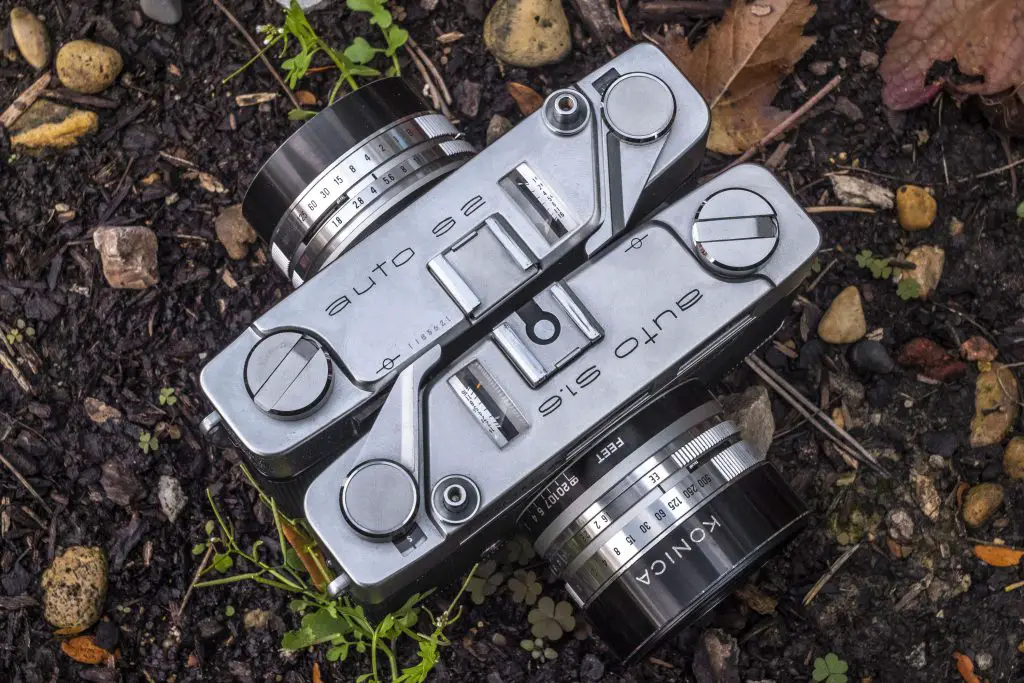















It occurred to me (too much time on my hands)that one could collect odd maximum apertures. Konica 1.6, Anticomar f2.9, Zeiss f 1.5, etc.
Two reasons these cameras are not more coveted (apart from wobble):
1. The mirror is often off in the RF.
Even though it’s “easy” to reglue it’s well beyond 99% of all peoples tools or abilities. Paying to have it fixed is just not something that crosses most peoples minds. If it does and they see the price for the work being up to 10x what they payed for the camera, most people forget about it.
2. The shutter is very often jammed, in some way or another.
It’s close brother the Hi-Matic 7s is every bit as good and is far more reliable.
It has a rep for being harder to repair, but I’ve not heard of any real repaying person ever refusing to work on one.
You could even argue the large number of Japanese rangefinders with f/1.9 lenses are non-standard. Of course, the creme de la creme is Canon’s f/0.95 lens, and slightly slower, but equally expensive, the Nikkor f/1.1 rangefinder lens!
Mike, I agree the Auto S1.6 is a wonderful camera with a crackerjack lens. While plastic used in the lens mount and battery cap is disappointing it’s still a superb photographic tool. Shutters in these cameras are typically stuck and the RF mirror can come unglued as pointed out, but those are minor CLA issues on a fifty-plus year old camera and ANY camera of this age will require a CLA to bring it up to snuff. (Whale oil lubricants didn’t age well)
Like you, I also don’t understand why Auto S-2’s are so undervalued, but it’s a treat to be able to snap up such an outstanding camera for a song. I think it’s important to note that Auto S1.6’s are fairly rare. It obviously wasn’t a big seller and was only offered in the US for two years (1968-1969). For this reason, the typical Auto S1.6 you might find is older, in need of significant repair and more worn than the average Auto S2. The decision should be made based mostly on condition. Auto S1.6 survivors in excellent operational condition are difficult to find.
Two key physical differences between the Auto S2 and Auto S1.6: the Auto S1.6 was only the second Konica model with a flash hot shoe, and the standard sliding lens hood of the Auto S2 was optional on the Auto S1.6. Although they’re basically the same cameras, the entire lens assembly of the Auto S1.6 is unique as the lens thread to film distance is different, as is the meter so if you find an Auto S1.6 in need of these parts, be aware you need to find a donor Auto S1.6 and that isn’t easy. Auto S2’s in tatty condition are typically consigned to the dust bin; Auto S1.6’s in the same condition invariably find their way to the resale market.
Konica also offered an exceedingly rare AS3 AUTO-UP close-up lens (fit both variants) that could not be used in tandem with the sliding hood. The hood had to be removed to fit the close-up lens but the AS3 AUTO-UP gets you as close as 17.7”. I’ve only seen the AS3 AUTO-UP come up a couple of times on eBay over the years and the seller never knew what it fit so you won’t have much competition if you’re bidding.
I agree with you that picking on these cameras because RF mirrors fall off or shutters get sticky is unfair as those are common problems that any half century year old camera could have. I didnt respond to the other poster for that reason.
I was not aware there were so many changes to the lens assembly on the 1.6. I did notice the lack of the lens hood on some examples. My S2 does not have one, but the S1.6 does. I figured that either it was an option or perhaps they’re just easy to remove and then lose.
I also didn’t know about the Auto Up. I’ve definitely never seen one of those, but will keep a look out! Could make for a fun update to this review if I ever find one. Thanks for all of the insightful comments!
Here again the poster you didn’t want to respond to… 😛
Whether it’s fair or not is besides the point.
When there is so many other rangefinders models that work more or less perfectly after fifty plus years. It’s hard to justify a repair.
Personally I’m getting ready to ship off an S2 to give it a real try.
I just have to chose which of the five bodies I have, I think has the best chance of being repairable.
But it’s going to cost me, and if photography was more of a casual hobby, or I was more strapped for cash I’d simply not do it, and find another camera model to use.
For example one of the four perfectly working Hi-Matic 7s I have.
I’m sorry, I didn’t meant to suggest I wouldn’t reply to you, I meant it as I didn’t want to reply as I didnt think that common issues like the RF falling off or a sticky shutter was any reason to declare them less desirable than a Hi-Matic. In my experience, all of these mid century leaf shutter rangefinders, regardless of who made them, have an equal chance of having problems. Sometimes you get lucky and they don’t need cleaning, but most of the time they do! 🙂
Miguel, muchas gracias por tan buen artículo! Las fotografías se ven lindas, y la nitidez de la lente es asombrosa! Además, comparto con tu opinión, de que, toda cámera de más de 50 años alguna cosa debe tener!…… Y será un placer envarla a reparar para disfrutar plenamente de fografías como la que realizastes.
Oscar.
My first post on this disappeared, so here goes a second time. Thanks for your enlightened explanations on the Konica history. I concur on the lens being brilliant. I have to put it alongside my Yashica Lynx 5000 Yashinon as unbeatable in the 1.8 fixed lens rangefinder class.
I was astounded by my Auto S2 ability to resolve distant details in a landscape picture.
That said, the S2 distance focus scale on the side in tiny writing is awful to use, and not helped by the throw movement as you mention. For that reason I still think my Lynx rules if only for the ease of use.
I suspect the plastic battery cap is to mitigate leaking batteries causing corrosion. A minor quibble I have with the Auto S2 is the rough feel of the winder. Regardless, I prefer it over many of my other rangefinders (Canon, Minolta and Olympus 35 SP). The 35 SP is also at the pinnacle of resolution, so my preferences are only related to pleasure of usage.
Thanks for the comments, Arnold. I agree, that when it comes down to the best of what companies like Konica, Yashica, Nikon, Minolta, and others made, performance is all pretty even, and it comes down to pleasure of usage. Sometimes the most miniscule cosmetic detail can be the deciding factor between two otherwise excellent cameras!
Arnold: The viewfinder focus patch in the Yashica Lynx series ruins it for me. I have a Lynx 14E and the lens could have made it a low light superstar is it weren’t for the dim, dreadful focus patch.
Mike,
I agree with Arnold Broese about the battery cap. I read somewhere that off-gassing from the mercury batteries corroded the wiring and other internal metal parts. I’m not sure, but I think the holes in the cap are drilled all the way through to allow the gas to escape.
Hi Mike,
many thanks for the very nice review! You mentioned “The other is Konica’s extremely poor decision to use a plastic lens mount.”
I have taken apart around fifty of these cameras (mostly S2 and a few 1.6) and I didn’t see any plastic. If the lens is abit wobbly, that is no problem to fix. The main segments of the lens are held together by a thin copper-ring, behind the front lens section. If you tighten that ring a bit too much, the lens rings (shutter-/ aparture-ring) are more difficult to turn. So the lens has to be a little bit wobbly, 1-2mm.
Admittedly, I’ve never taken one apart, but was told there was a plastic plate that the lens was mounted to by someone else. Perhaps it’s the thin copper ring that causes the wobble. While only a time machine would prove exactly how loose these were when they were new, every single example I’ve handled (S, S2, and S1.6) all do it, so it’s probably that ring you’re talking about. I just wish they had come up with a better method, as that’s really my only complaint about an otherwise excellent camera! Thanks for the correction.
That wobble used to irritate me a touch, but it’s true, I’ve yet to come across one that doesn’t do this. It affects the shooting and performance not at all and never seems to get worse. Part of its charm. 🙂
Excellent, detailed write up, as per usual, Mike. You’ve nailed. I had my S2 out several weeks ago and each time I do so I’m reminded how great these are to shoot with. I’ve resuscitated 3 or 4 of these now for affordable local sale and each person to use them has been elated. These have been and are still one of the best compact RF values to be found anywhere. And my goodness, that Hexanon.
I bought two Konica S1.6 Auto cameras in 2023 and gave them to Ed Trzoska to restore one into a usable camera. Ed did an excellent job and I am extremely pleased with his thoroughness. The S1.6 Auto is a large camera and quite heavy, but that means it is also fairly robust. I am very pleased with the 45mm f1.6 lens at all stops, which seems to give very good to excellent rendition in terms of colour and excellent detail, particularly when using a monopod or braced, in comparison to my Nikkor 50mm f1.4 Ais on a Nikon FM3a, except for occasional flare directly into the sun. The sweetspot is around f5.6-f8, but I think most would be more pleased with the images than the ones from my Nikkor 50mm F1.4 ais of a similar vintage. The camera has a leaf shutter that synchronises up to 1/500 with electronic flash, which can be handy, the meter is reasonably accurate for monochrome (Ilford) and C41 (Kodak Gold & Portra) but I mostly use a Sekonic meter for E6 (currently old Fuji Provia etc). I find that focussing is very clear but the focus lever has a tiny range of motion, so sometimes it takes a little longer to pinpoint the focus. Framing is okay if you don’t rely on the framelines being absolutely correct, and mechanical reliability has been great (so far!). I feel that the lens resolution of the S1.6 Auto is excellent, and that means that you may get detail when photographing people, for example, that may need adjustment after development if you are making big enlargements. Would I recommend the S1.6 Auto? Yes I would, particularly at current prices, as the lens is really crisp!